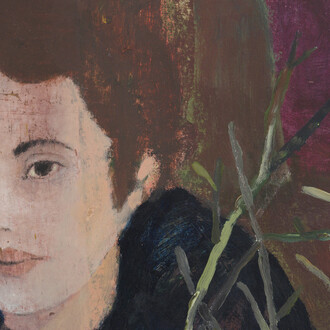‘Quantifiable’, Analia Saban’s sixth exhibition at Praz Delavallade Paris, questions the legibility—and, by extension, the legitimacy— of various kinds of statistical graphics. Working with paint, canvas and hunks of minerals, Saban evokes pie charts and line graphs typically seen in newspapers, medical journals or corporate earnings reports. What, if anything, is being measured by these large-scale, tactile graphs and charts remains a mystery. Instead of representing specific data points, these works examine the very notion of what it means to be « quantifiable. »
The weavings and sculpture presented in this exhibition are like Rorschach ink blot tests in that they reveal more about the viewer’s psyche than the outside world. Looking at any one work on view, two people might have entirely different inklings about what kind of data is ostensibly being charted. The steep downward sloping red line in Market Trend #5932, (2022), could just as easily represent a drop in Covid-19 cases or a crashing stock market. Such discrepancies expose a link between presumed objective metrics and highly subjective abstractions. Playing on our ability—indeed our inclination—to attach meaning to a random curved line, Saban reminds us that bias is always at play when it comes to collecting, presenting and interpreting data.
In addition to acting as a kind of projective psychological test, Saban’s wood and rock sculpture, free-hanging tapestries and panel-mounted weavings have an intrinsic art historical context in which they resemble some Minimalist paintings and sculptures from the 1960s and 1970s. The bowed lines charting a path of unspecified data along unidentified «X» and «Y» axes recall Robert Mangold’s linear vocabulary and Ellsworth Kelly’s curvaceous forms. The equally enigmatic pie charts call to mind methodical studies of circles and circle segments by Sol LeWitt or François Morellet. And a three-dimensional graph whose highs and lows are illustrated with peaked fragments of red and green marble evokes some of Dewain Valentine’s colorful high-gloss sculptures. Such formal comparisons support the notion that data analysis is more abstract than we might like to think.
With the exception of Volatility, (2022), all of the works on view were produced on a Jacquard loom using linen and acrylic «threads», which Saban makes by brushing long strokes of acrylic paint on a flat surface and peeling these off once they’ve dried.
This technique complicates her final works’ formal affinities with Minimalism and also challenges traditional categories of artmaking. Whether these works are considered paintings, weavings or something else entirely could have quantifiable ramifications when it comes to contemporary conversations about fine art vs. craft. And while today’s art market largely values paintings over weavings, Saban’s artworks are in fact reminders that this was not always the case. In the Middle Ages and early Renaissance tapestries were the ultimate luxury, more valuable at that time than paintings. When it comes to being «quantifiable», art—like data— is very much a matter of context and bias.
(Mara Hoberman)
Analia Saban (born in 1980 in Buenos Aires, Argentina) lives and works in Los Angeles. She received a BFA in Visual Arts from Loyola University in New Orleans in 2001, followed by an MFA in New Genres at the University of California in Los Angeles in 2005. Saban’s work is included in numerous collections: the Hammer Museum at UCLA, Museum of Contemporary Art, and Los Angeles County Museum of Art in Los Angeles; Hessel Museum of Art at Bard College in New York; Norton Museum of Art in Florida; Centre Pompidou in Paris, and Fundación Proa in Buenos Aires, among others.
















